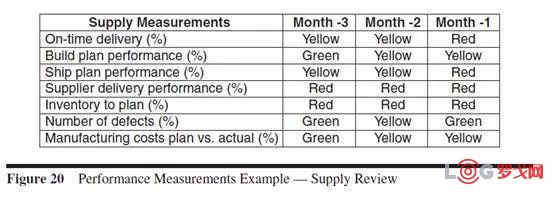

 [罗戈导读]S&OP经典书籍连载:企业销售与运营计划(24)【第五章:S&OP评审会议(3)-RCCP
[罗戈导读]S&OP经典书籍连载:企业销售与运营计划(24)【第五章:S&OP评审会议(3)-RCCP

He advances the computer presentation to the next slide (Figure 20). “Here’s an example of a performance measurement review format,” he says. “Just like the sales and operations planning dashboard, shown earlier in the morning, a green, yellow, and red system is employed to show performance at a glance.”
他将计算机演示推进到下一张幻灯片(图20)。他说:“这是一个绩效衡量审查格式的例子。”“就像早上早些时候显示的销售和运营计划仪表盘一样,使用绿色、黄色和红色系统来一目了然地显示绩效。”

Nolan continues to explore the supply review subprocess. He tells the group that the performance review is followed by a review of the newly updated demand plan, or request for product. The purpose of this review is to determine whether the supply side of the business can support the changes in the demand plan and still maintain current resources and projected costs. A simulation of capacity, called rough-cut capacity planning, is commonly used to determine Feasibility.
诺兰继续探索供应审查子流程。他告诉小组,绩效评估之后是对最新更新的需求计划或产品需求的评估。本次审查的目的是确定企业的供应侧是否能够支持需求计划的变更,并仍然保持现有资源和预计成本。产能模拟通常被称为粗略产能规划,用于确定可行性。
Nolan is quick to point out that rough-cut capacity planning is different from detailed capacity planning. Rough-cut capacity planning is known as a “first cut” at attempting to answer some questions: Do we have a reasonable chance to support the demand plan? Do we have sufficient resources to support the plan? Are our resources “sized” correctly? If the answer to any of these questions is no, the supply team is responsible for taking action or making recommendations to take action to solve the out-of-balance condition.
诺兰很快指出,粗略的产能规划不同于详细的产能规划。在试图回答一些问题时,粗略的产能规划被称为“第一次削减”:我们是否有合理的机会支持需求计划?我们有足够的资源支持这项计划吗?我们的资源“规模”是否正确?如果这些问题的答案为“否”,则供应团队负责采取行动或提出建议,采取行动解决失衡状况。
“In essence, rough-cut capacity planning is a ‘what if’ simulation that tests whether you can commit to support the new demand plan without changing one of the knobs we talked about before,” Nolan says.
诺兰说:“本质上,粗略的产能规划是一个假设模拟,它测试你是否可以承诺支持新的需求计划,而不改变我们之前讨论过的一个旋钮。”
“When you use the term rough-cut capacity planning, are suppliers included in the simulation?” Anita Cooper, the purchasing manager, asks. Nolan asks the group to turn to page 47 in their notebooks, which provides more details about rough-cut capacity planning. He explains that it is imperative to have the ability to perform multiple simulations quickly and easily. There are usually multiple planning options, and it is frequently desirable to test more than one production/supply plan alternative against the demand request for product. Another principle of rough-cut capacity planning is the simulation of key resources only. “Not all resources are simulated,” Nolan says. “Just the ones that are likely to cause problems.”
“使用“粗略产能规划”一词时,模拟中是否包括供应商?”采购经理安妮塔·库珀问道。诺兰要求小组翻到他们笔记本中的第47页,该页提供了关于粗略产能规划的更多细节。他解释说,必须具备快速、轻松地执行多个模拟的能力。通常有多个计划选项,通常需要针对产品的需求请求测试多个生产/供应计划备选方案。粗略产能规划的另一个原则是只模拟关键资源。“并不是所有的资源都是模拟的,”诺兰说。“只有那些可能引起问题的人。”
He tells the group that key resources typically are bottlenecks or constraints. They may be resources that are difficult or expensive to change. He goes on to list typical categories of key resources: skills, materials, engineering, money, or any other item that may be a constraint in supporting the new demand request. “And, yes, Susan,” Nolan says, “they may include key suppliers as well as internal resources. Additionally, the key constraints may actually be key materials. These can be simulated as well as capacity.”
他告诉小组关键资源通常是瓶颈或约束。它们可能是难以改变或代价高昂的资源。他接着列出了关键资源的典型类别:技能、材料、工程、资金,或任何其他在支持新需求请求方面可能受到限制的项目。“是的,苏珊,”诺兰说,“他们可能包括关键供应商和内部资源。此外,关键约束实际上可能是关键材料。这些可以模拟,也可以模拟容量。”
Nolan explains that the objective is to first identify any constraints so that alternative approaches can be developed to support the demand. It would be unusual to find that all resources are constraints. Depending upon the volume and the product mix, it is typical to find a limited number of constraints during any particular period in time.
诺兰解释说,目标是首先确定任何的限制条件,以便开发替代方法来支持需求。很难发现所有资源都是约束条件。根据产量和产品组合,通常在任何特定时间段内找到有限数量的限制条件。
“Remember,” Nolan says, “in a demand-driven organization with the objective to meet customers’ expectations all the time, you should be predisposed to find a way to say yes to the new demand request for product. If it costs more to do so, the implications of supporting the plan should surface as a management issue in the sales and operations planning process. The cost of not meeting marketplace expectations may ultimately be far greater than the added cost to manufacturing or engineering.”
“记住,”诺兰说,“在一个以满足客户期望为目标的需求驱动型组织中,你应该倾向于找到一种方法来对产品的新需求请求表示同意。如果这样做的成本更高,支持计划的影响应该在销售和运营计划过程中作为管理问题显现出来。不满足市场预期的成本最终可能远远高于制造或工程的附加成本。”
Susan raises her hand. “If this is only rough-cut capacity planning, when is more detailed capacity planning performed?” Nolan tells the group the detailed capacity planning is usually performed as part of the master scheduling process. The additional detail simulated typically includes testing resources for an expanded number of variables, including product mix, a more detailed simulation of resources, and specific days or weeks. Detailed capacity planning is commonly performed more frequently than once a month, usually weekly or sometimes even daily.
苏珊举起手来。“如果这只是粗略的产能规划,那么何时执行更详细的产能规划?“诺兰告诉小组详细的产能计划通常作为主计划流程的一部分执行。模拟的额外细节通常包括扩展变量数量的测试资源,包括产品组合、更详细的资源模拟以及特定的天数或周数。细产能规划通常每月执行一次以上,通常每周甚至每天执行一次。
Nolan stops and surveys the room. He wants to make sure that the group understands the differences between rough-cut capacity planning and detailed capacity planning. He explains that for sales and operations planning, rough-cut capacity planning is performed monthly and at an aggregate level. For example, rough-cut capacity planning may simulate the demand of all product groups for the capacity of an entire work center, which may consist of three machines. In contrast, detailed capacity planning may simulate each machine in that same work center.
诺兰停下来等问题。他希望确保小组了解粗产能规划和细产能规划之间的差异。他解释说,对于销售和运营计划,粗略的产能计划每月执行一次,并在总水平上执行。例如,粗略的产能规划可以模拟所有产品组对整个工作中心产能的需求,该工作中心可能由三台机器组成。相反,细产能规划可以模拟同一个工作中心中的每台机器。
Nolan clicks the mouse to advance to the next slide (Figure 21). “Here is an example of a rough-cut capacity planning presentation for one resource,” he says. The vertical columns represent requirements for the capacity in time periods. The bottom line represents demonstrated capacity. The middle line represents planned capacity, and the top line represents maximum capacity. Nolan
单击鼠标前进到下一张幻灯片(图21)。他说:“这是一个针对一种资源的粗产能规划演示的例子。”垂直列表示时间段内的容量要求。底线代表展示的能力。中间一行表示计划的能力,顶一行表示最大容量。

The power of rough-cut capacity planning is its ability to demonstrate whether the resources are ‘sized’ correctly to support what we chose to do in the marketplace,”
“粗略的产能规划的作用在于,它能够证明资源规模是否正确,以支持我们在市场上选择的做法。”
Nolan comments. “It not only identifies problems of projected capability shortages, but it also identifies opportunities where there is projected capacity available. For master scheduling, additional detailed capacity simulations may be required to ensure that the detailed schedule is feasible and can be supported by the company resources.”
诺兰评论。“它不仅搞清了预测能力短缺的问题,而且还搞清了存在预测能力可用的机会。对于主计划,可能需要进行额外的细产能模拟,以确保详细计划可行,并得到公司资源的支持。”
Nolan looks at Jim, Guy, and Susan. He tells them that two books are required reading: Gaining Control by James Correll and Norris Edson and Master Scheduling by John Proud.
诺兰看着吉姆、盖伊和苏珊。他告诉他们要阅读两本书:由詹姆斯·科雷尔和诺里斯·埃德森写的《获得控制》,约翰·普劳德写的《主排产计划》。
Jim Simpson raises his hand. “What about inventory and customer lead times? Are they considered in the supply planning process?”
吉姆·辛普森举起手来。“库存和客户交货时间怎么办?在供应计划过程中是否考虑这些因素?“
“Yes, they are,” Nolan replies. “In previous sales and operations planning cycles, you will set targets for inventory and customer lead times by product line or product group. The demand planning process could request changes in those targets along with their updated demand plan, or request for product. The load on key resources includes meeting inventory and lead time targets.”
“要,是要考虑的,”诺兰回答。“在以前的销售和运营计划周期中,将按产品线或产品组设置库存和客户交货期的目标。需求计划过程可以请求更改这些目标及其更新的需求计划,或者请求产品。关键资源的负担包括满足库存和交货期目标。”
He explains that in response to requests for changes in inventory and lead time targets as well as the updated demand plan, the supply organization develops a volume production plan by month. This plan should (1) satisfy customer delivery requirements, or shipments; (2) conform as closely as possible to inventory targets; and (3) meet as closely as possible customer lead-time targets. To achieve all three aims requires tactics that address how much inventory is required to support the desired customer lead-time targets. “The process for determining these tactics frequently is called ‘where to meet the customer,’” Nolan says.
他解释说,为了响应库存和交货期目标以及更新的需求计划的变更要求,供应部门按月制定批量生产计划。该计划应(1)满足客户交货要求或出货;(2)尽可能接近库存目标;(3)尽可能接近客户交货期目标。要实现这三个目标,需要策略来解决支持所需客户提前期目标所需的库存量。诺兰说:“确定这些策略的过程经常被称为‘在哪里会见客户’。”
He further explains that determining the tactics is a key element of implementing a combined marketing–manufacturing strategy. It also is necessary for effective master scheduling.
他进一步解释说,确定策略是实施联合营销-制造战略的关键要素。有效的主调度也是必要的。
“This could be the subject of another class,” Nolan tells the group, “and we will have much discussion on inventory and lead time tactics as we work with you to develop your sales and operations planning process. For now, let’s just acknowledge that we must decide what our tactics will be and set targets accordingly.”
“这可能是另一个课程的主题,”诺兰告诉小组,“在我们与你们合作开发销售和运营计划流程时,我们将对库存和交货期策略进行大量讨论。现在,我们承认,我们必须决定我们的战术,并相应地设定目标。”
Susan raises her hand. “Before we move on, doesn’t this whole conversation imply that the production plan could be different from the backlog of customer orders? Also, couldn’t the production plan be different from what is planned to be sold?”
苏珊举起手来。“在我们继续之前,整个对话是否意味着生产计划可能与客户订单积压有所不同?另外,生产计划和销售计划有什么不同吗?”
Mark admires Susan’s approach. She already knows the answers to the questions she has asked, but she wants everyone else to hear the answers from an industry expert. She has some points to make, and she is going to let Nolan make them for her. “You’re correct, Susan,” Nolan replies. “We call it the decoupling of demand and supply.” He explains that, stated simply, decoupling of demand and supply involves choosing to produce at a rate different than the shipment rate or the bookings rate. To the extent that these rates are different, either inventory or customer lead time (backlog), or both, will need to be varied.
马克赞赏苏珊的举动。她已经知道了她所问问题的答案,但她希望其他人都能听到一位行业专家的答案。她有一些要点要讲,她要让诺兰为她讲。“你说得对,苏珊,”诺兰回答。“我们称之为供需分离。”他解释说,简单地说,供需分离涉及选择以不同于出货率或预订率的速度生产。如果这些比率不同,库存或客户提前期(积压)或两者都需要改变。
“The principle of decoupling demand and supply gives the supply side of the business improved control over two of the three knobs — the time knob, or schedule, and the resource knob, or people, equipment, etc.,” Nolan says. “Even though the production plan is different from the customer order backlog when demand and supply are decoupled, the production plan still must support current orders on the books, or backlog, and the anticipated demand.”
诺兰说:“将需求和供应分离的原则使企业的供应部门能够更好地控制三个旋钮中的两个——时间旋钮或者说时间表,以及资源旋钮,或者人、设备等。”“即使生产计划不同于需求和供应分离时的客户订单积压,生产计划仍然必须支持帐面上的当前订单或积压以及预期需求。”
Nolan displays the next slide in his presentation (Figure 22). He asks the group to consider the point made by the graphic. It is a reality that demand fluctuates. It is also a reality that a level production schedule is most cost effective. Decoupling demand and supply enables companies not to force demand to conform to a level production schedule. It also gives the manufacturing function the ability to produce more cost effectively.
诺兰在他的PPT中放了下一张幻灯片(图22)。他要求小组考虑图片中的重点。需求波动是现实。事实上,水平生产计划最具成本效益。将需求和供应分离使企业不必强迫需求符合水平生产计划。它还为制造功能提供了更具成本效益的生产能力。



美的社招供应链专员
4906 阅读
京东社招综合支持组负责人,风控督导岗,营业部经理、能力提升岗,物流方案实施
4901 阅读
顺丰社招SME客户经理、运作管理专员、医药-KA客户经理、后端高级工程师、司机组长等
3877 阅读盒马社招仓储运营(生鲜)、配送经理、店仓经理
3526 阅读招贤纳新丨美通招聘这些岗位人才
3488 阅读菜鸟社招供应链管理(美护)、供应链数字化解决方案架构师、WMS/WCS海外产品经理、全链路运营、澳新末端运营等
3502 阅读天津港集团面向社会公开选聘副总裁
3444 阅读深圳联合船代2025届校园招聘物流等专业岗位
3312 阅读商舟航空物流2025届校园招聘
3128 阅读喜百年社招分公司城市负责人、物流销售总监、国际物流销售专员/经理、物流销售、大客户销售经理、JAVA后端开发工程师
2944 阅读